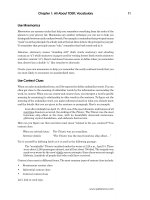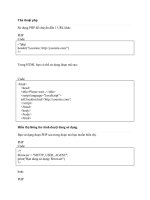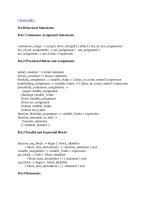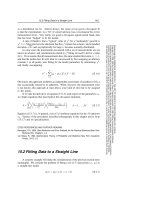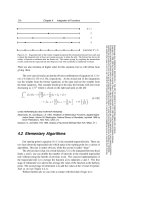Tài liệu User Defined Primitives part 3 docx
Bạn đang xem bản rút gọn của tài liệu. Xem và tải ngay bản đầy đủ của tài liệu tại đây (30.43 KB, 5 trang )
[ Team LiB ]
12.4 UDP Table Shorthand Symbols
Shorthand symbols for levels and edge transitions are provided so UDP tables can
be written in a concise manner. We already discussed the symbols ? and A
summary of all shorthand symbols and their meaning is shown in Table 12-1
.
Table 12-1. UDP Table Shorthand Symbols
Shorthand
Symbols
Meaning Explanation
? 0, 1, x Cannot be specified in an output field
b 0, 1 Cannot be specified in an output field
- No change in state
value
Can be specified only in output field of a
sequential UDP
r (01) Rising edge of signal
f (10) Falling edge of signal
p (01), (0x) or (x1) Potential rising edge of signal
n (10), (1x) or (x0) Potential falling edge of signal
* (??) Any value change in signal
Using the shorthand symbols, we can rewrite the table entries in Example 12-9 on
p
age 263 as follows.
table
// d clock clear : q : q+ ;
? ? 1 : ? : 0 ; //output = 0 if clear = 1
? ? f : ? : - ; //ignore negative transition of clear
1 f 0 : ? : 1 ; //latch data on negative transition of
0 f 0 : ? : 0 ; //clock
? (1x) 0 : ? : - ; //hold q if clock transitions to unknown
//state
? p 0 : ? : - ; //ignore positive transitions of clock
* ? 0 : ? : - ; //ignore any change in d when
//clock is steady
endtable
N
ote that the use of shorthand symbols makes the entries more readable and more
concise.
[ Team LiB ]
[ Team LiB ]
12.5 Guidelines for UDP Design
When designing a functional block, it is important to decide whether to model it as
a module or as a user-defined primitive. Here are some guidelines used to make
that decision.
• UDPs model functionality only. They do not model timing or process
technology (such as CMOS, TTL, ECL). The primary purpose of a UDP is
to define in a simple and concise form the functional portion of a block. A
module is always used to model a complete block that has timing and
process technology.
• A block can modeled as a UDP only if it has exactly one output terminal. If
the block to be designed has more than one output, it has to be modeled as a
module.
• The limit on the maximum number of inputs of a UDP is specific to the
Verilog simulator being used. However, Verilog simulators are required to
allow a minimum of 9 inputs for sequential UDPs and 10 for combinational
UDPs.
• A UDP is typically implemented as a lookup table in memory. As the
number of inputs increases, the number of table entries grows exponentially.
Thus, the memory requirement for a UDP grows exponentially in relation to
the number of inputs. It is not advisable to design a block with a large
number of inputs as a UDP.
• UDPs are not always the appropriate method to design a block. Sometimes it
is easier to design blocks as a module. For example, it is not advisable to
design an 8-to-1 multiplexer as a UDP because of the large number of table
entries. Instead, the data flow or behavioral representation would be much
simpler. It is important to consider complexity trade-offs to decide whether
to use UDP to represent a block.
There are also some guidelines for writing the UDP state table.
• The UDP state table should be specified as completely as possible. All
possible input combinations for which the output is known should be
covered. If a certain combination of inputs is not specified, the default
output value for that combination will be x. This feature is used frequently in
commercial libraries to reduce the number of table entries.
• Shorthand symbols should be used to combine table entries wherever
possible. Shorthand symbols make the UDP description more concise.
However, the Verilog simulator may internally expand the table entries.
Thus, there is no memory requirement reduction by using shorthand
symbols.
• Level-sensitive entries take precedence over edge sensitive entries. If edge-
sensitive and level-sensitive entries clash on the same inputs, the output is
determined by the level-sensitive entry because it has precedence over the
edge-sensitive entry.
[ Team LiB ]
[ Team LiB ]
12.6 Summary
We discussed the following aspects of Verilog in this chapter:
• User-defined primitives (UDP) are used to define custom Verilog primitives
by the use of lookup tables. UDPs offer a convenient way to design certain
functional blocks.
• UDPs can have only one output terminal. UDPs are defined at the same level
as modules. UDPs are instantiated exactly like gate primitives. A state table
is the most important component of UDP specification.
• UDPs can be combinational or sequential. Sequential UDPs can be edge- or
level-sensitive.
• Combinational UDPs are used to describe combinational circuits where the
output is purely a logical combination of the inputs.
• Sequential UDPs are used to define blocks with timing controls. Blocks such
as latches or flipflops can be described with sequential UDPs. Sequential
UDPs are modeled like state machines. There is a present state and a next
state. The next state is also the output of the UDP. Edge- and level-sensitive
descriptions can be mixed.
• Shorthand symbols are provided to make UDP state table entries more
concise. Shorthand notation should be used wherever possible.
• It is important to decide whether a functional block should be described as a
UDP or as a module. Memory requirements and complexity trade-offs must
be considered.
[ Team LiB ]
[ Team LiB ]
12.7 Exercises
1:
Design a 2-to-1 multiplexer by using UDP. The select signal is s, inputs
are i0, i1, and the output is out. If the select signal s = x, the output out is
always 0. If s = 0, then out = i0. If s = 1, then out = i1.
2:
Write the truth table for the boolean function Y = (A & B) | (C ^ D).
Define a UDP that implements this boolean function. Assume that the
inputs will never take the value x.
3:
Define a level-sensitive latch with a preset signal. Inputs are d, clock, and
p
reset. Output is q. If clock = 0, then q = d. If clock = 1 or x, then q is
unchanged. If preset = 1, then q = 1. If preset = 0, then q is decided by
clock and d signals. If preset = x, then q = x.
4:
Define a positive edge-triggered D-flipflop with clear as a UDP. Signal
clear is active low. Use Example 12-9
on page 263 as a guideline. Use
shorthand notation wherever possible.
5:
Define a negative edge-triggered JK flipflop, jk_ff with asynchronous
p
reset and clear as a UDP. q = 1 when preset = 1 and q = 0 when clear = 1.
The table for a JK flipflop is shown below.
6:
Design the 4-bit synchronous counter shown below. Use the UDP jk_ff
that was defined above.
[ Team LiB ]


